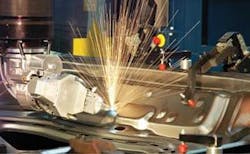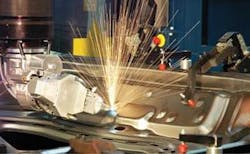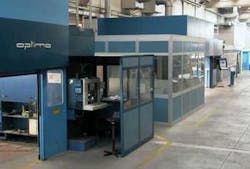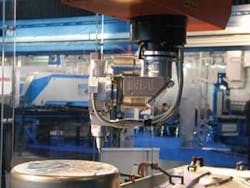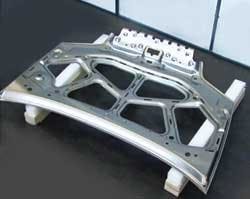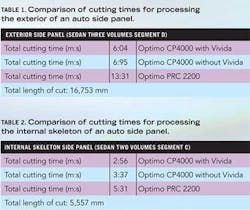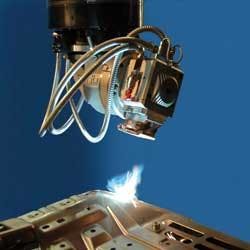Improving multi-axis laser cutting
New technology enables one company to broaden its commercial offerings by entering new fields
by Antonio Vendramini
Massimo Bovi, the CEO of Sallig (www.sallig.it), says, “We began operations with a team of ten ‘sheet metal beaters’ whose job was to manually execute prototypes for Fiat in a craftsman’s manner. We then evolved, growing technologically and acquiring CNC milling machines, but we essentially remain in the same sector, today supplying automotive companies around the world.”
“Our work begins,” Bovi continues, “with the CAD data received from the client or from our parent company and continues with a study of the method, numerical simulation, and design of production equipment, in order to arrive at the construction of dies and execution of prototypes, pilot production, or limited-volume product lines. Several years ago we installed a spot welding facility to produce complete body-in-white auto bodies, and recently we have installed higher-power welding machines. If requested, we are able to complete the vehicle assembly, integrating the mechanics, auxiliary systems, and interior and exterior trims, in order to analyze their ease of assembly and the assembly sequence as a kind of process validation.”
Bovi says that, “On average we produce around 1500 dies a year. In our machine pool we have four Optimo laser systems, which trim the stamped pieces. We installed our first laser robot in 1982: it was one of the first ZAC systems with a movable table by Prima Industrie. Other older laser systems are still in use today, including a 1999 Prima Optimo with a 2.2kW CO2 laser (see Figure 1).
Sallig waited almost ten years to acquire a fourth laser system, partly because of uncertainties in the auto market but more substantially due to the search for a laser system that would permit a quantum leap in terms of cutting quality or reduced time, while allowing ease of use, even for production of low-volume products.
According to Bovi, the company was interested in another Prima laser system, the Rapido Evoluzione becasue of the X axis increase to 4000 mm, and a new laser head directly driven by motors and transducers without gears or moving parts producing higher tolerances and accelerations. This unit’s drawback, Bovi says, was its available working envelope, which did not allow pieces like an entire vehicular side panel to be procesed.
The resolution to this Bovi found in the new Prima Industrie Optimo system, which utilizes the Vivida laser head. This unit offers: X, Y, and Z axes with 4500 mm x 2500 mm x 1020 mm, significant tolerances (0.03 mm for the linear axes and 0.005° for the rotating axes), and elevated accelerations (40 m/s2 on the adaptive C axis, now controlled by the CNC, and 12 m/s2 acceleration on the new W axis). Bovi says, “It was evident this system was the answer to our needs, and we decided to acquire it.”
This system is fitted with a 4.0 kW laser source and PRIMACH-20L CNC control, both developed in the Prima Industrie Group, so it is able to work with the new sheet metal plates made of high-strength steel and even with those made of aluminum alloy. After six months in use, Sallig is pleased with the operational results after some minor modifications, like lowering the base and the level of the two work platforms in the as-delivered ‘split-cabin’ structure, done to allow access to a completed auto body that requires laser welding operations.
An apt definition of the Vivida concept provided by Prima Industrie’s Marketing Director Domenico Appendino is to think of a pianist. “While the pianist’s arms gesture broadly as they move above the keyboard, the pianist’s fingers make small and rapid movements, which touch the keys themselves. In order to generate harmonious music, the pianist’s brain synchronizes the two motions. The Optimo Vivida system is, in reality, made up of two different components: the traditional handling movements of the Optimo Evoluzione unit, which represent the pianist’s arms and direct the laser beam inside the large working envelope with accelerations of 4 m/s2 for the linear axes, and the laser head, which is the pianist’s hands and represents a little, lightweight auxiliary machine capable of executing extremely fast movements, thanks to its W axis parallel to the B axis inside a 20 mm x 20 mm x 20 mm working envelope (see Figure 2). Dedicated software developed by Prima Industrie controls a little auxiliary machine that is perfectly integrated with the principal axes, and the PRIMACH CNC control synchronizes the movements of the ‘principal machine’ with the movements of the ‘little machine.’
This design contributes to the increased reliability of the entire system, with the principal handling movements being less stressed because all the rapid shifting movements are relegated to the ‘little machine,’ which acts to relieve the main unit. A second user advantage is that with the combined action of the two machines, it is possible to attain maximum performance in terms of work speed along a cutting trajectory made intricate by the presence of numerous holes or by the need for digging out precise cavities. To better understand this, processing data from Sallig is shown in Tables 1 and 2.
In a specific example, the inner panel of an auto’s hood can be processed in 3 min 58 s utilizing the older Optimo, while the same component using the same procedure cut with the Vivida head takes only 2 min 55 s, in 27 percent less time (see Figure 3).
Bovi says, “The advantages derived from using the Vivida solution are obvious, and they turn out to be greater percentage-wise as the designs of the cut increase in complexity. So we have been increasing our penetration into another market sector, like the washing machines industry, that has been less susceptible to the current contraction in the industry. This unit can also be used for laser welding (see Figure 4). Currently we are focusing on sheet-metal components for electrical household appliances, where making holes and slots as part of a continuous trim is predominant, and we expect that the advantages to be had from using the Vivida solution will be even greater.
Bovi concludes, “We’re excited about the performance of the new system. Thanks to this technological solution, we have been able to broaden our commercial offerings by entering new fields which, in all probability, will allow us to get through the uncertain times of the global economic crisis we are in.”
Dr. Antonio Vendramini ([email protected]) is a well known and highly respected expert and consultant in industrial laser materials processing.
